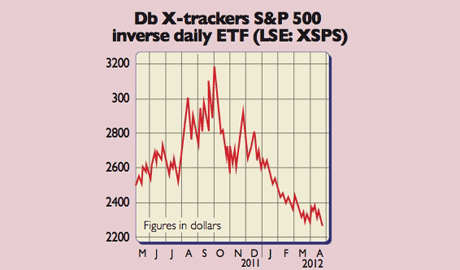Prepare to catch as the markets' levitation trick fails
Paul Amery explains how to bet against the market with an inverse exchange-traded fund (ETF) and tips one fund to buy now.

Investors who bet on falling prices get a bad rap. Bullish company executives, motivated by options-based pay, dislike those who query their firms' share prices. Regulators get twitchy whenever the phrase short selling' pops up. And no one likes a nay-sayer. Nonetheless, those betting on periodic declines have history and facts behind them.
Markets can overshoot to the upside as easily as they become undervalued. It's clear that one of the (unspoken) objectives of quantitative easing (QE) is to protect banks by inflating a whole range of asset prices, from government bonds, to shares, to residential and commercial property. If this levitation trick fails, watch out and be ready to benefit.
Inverse exchange-traded funds (ETFs) allow you to profit from a decline in a market index. Their price moves in an inverse direction to that of the benchmark. If you buy an inverse ETF on the FTSE 100 and the index declines 5% in a day, your ETF should rise 5% (or thereabouts inverse ETFs' prices reflect a small adjustment for interest rates and the cost of shorting). Leveraged ETFs work in the same way, but they double (or treble) the daily price change.
MoneyWeek
Subscribe to MoneyWeek today and get your first six magazine issues absolutely FREE

Sign up to Money Morning
Don't miss the latest investment and personal finances news, market analysis, plus money-saving tips with our free twice-daily newsletter
Don't miss the latest investment and personal finances news, market analysis, plus money-saving tips with our free twice-daily newsletter
The key thing to note about these funds is that they rebalance their index exposure each day. This means that, over longer time periods, you'll find that the return on an inverse or leveraged ETF diverges from the equivalent multiple of the underlying index. The more volatile the underlying index and the higher your leverage factor, the greater the return divergence.
As a result, you shouldn't hold a leveraged fund for more than a day or two. However, simple inverse ETFs (those offering one times the inverse of the index return) suffer much less from this return drift'. So investors shouldn't rule out holding them in accounts that would otherwise be long-only' such as Sipps or Isas.

ETF provider db X-trackers offers the broadest range of inverse ETFs, covering a variety of indices. Not all are heavily traded, so ask your broker to quote a bid and offer (buy and sell) price. An illiquid product will suffer a wide spread. If, like me, you're in the camp of those who think US equities are overvalued, the db X-trackers S&P 500 inverse daily ETF (which I own, LSE: XSPS) is a useful tool.
The firm's inverse trackers for American, British and eurozone government bonds are also worth considering.
Paul Amery edits www.indexuniverse.eu, the top source of news and analyses on Europe's ETF and index-fund market.
Get the latest financial news, insights and expert analysis from our award-winning MoneyWeek team, to help you understand what really matters when it comes to your finances.
Paul is a multi-award-winning journalist, currently an editor at New Money Review. He has contributed an array of money titles such as MoneyWeek, Financial Times, Financial News, The Times, Investment and Thomson Reuters. Paul is certified in investment management by CFA UK and he can speak more than five languages including English, French, Russian and Ukrainian. On MoneyWeek, Paul writes about funds such as ETFs and the stock market.
-
 My market predictions for 2026
My market predictions for 2026Opinion My 2026 predictions, from a supermarket merger to Dubai introducing an income tax and Britain’s journey back to the 1970s
-
 Where did house prices rise and fall the most in 2025?
Where did house prices rise and fall the most in 2025?Some parts of the UK have seen yearly property price growth of up to 12.6%, but others have seen values fall by as much as 8.9%, research shows.
